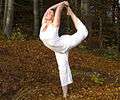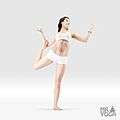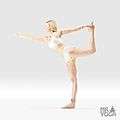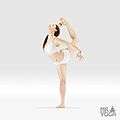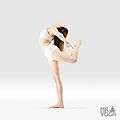Natarajasana
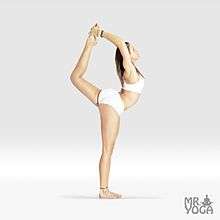
Natarajasana (Sanskrit: नटराजासन; IAST: Naṭarājāsana) or Lord of the Dance Pose[1] is a standing, back-bending asana [2].
Etymology
The name comes from the Sanskrit words nata meaning "dancer", raja meaning "king",[3] and asana (आसन) meaning "posture" or "seat".[4] Nataraja is one of the names given to the Hindu God Shiva in his form as the cosmic dancer.
Description
This is a balance asana that strengthens the legs. It also is a full body stretch which engages the shoulders, chest and abdomen, strengthens the thigh and calf muscles, knees and ankles, hips and spine, and develops concentration and grace.[5]
This aesthetic, stretching and balancing asana is used in Indian classical dances.
To get into this position, start in mountain pose or tadasana. Bend your left knee so your knee points down towards the ground and your heal moves toward your seat. Grab the inside of your left foot with your left palm. Spread your left toes, and kick your palm, moving your foot into the air faster than your chest moves forward. Broaden your collar bones. To move into the full variation of this pose, extend the right arm behind you and reach for the left foot. This may be more accessible with a yoga strap. [6].
Variations
See also
References
- ↑ "Yoga Journal - Lord of the Dance Pose". Retrieved 2011-04-09.
- ↑ https://www.verywell.com/king-dancer-pose-natarajasana-pose-3567090
- ↑ Gerstein, Nancy (12 August 2008). Guiding Yoga's Light: Lessons for Yoga Teachers. Human Kinetics. pp. 118–. ISBN 978-0-7360-7428-5. Retrieved 25 June 2011.
- ↑ Sinha, S.C. (1 June 1996). Dictionary of Philosophy. Anmol Publications PVT. LTD. p. 18. ISBN 978-81-7041-293-9. Retrieved 9 April 2011.
- ↑ Sŕivatsa Ramaswami (1 January 2001). Yoga for the three stages of life: developing your practice as an art form, a physical therapy, and a guiding philosophy. Inner Traditions / Bear & Co. p. 186. ISBN 978-0-89281-820-4. Retrieved 25 June 2011.
- ↑ https://www.doyouyoga.com/troubleshooting-king-dancer-pose-23389/
Further reading
- Iyengar, B. K. S. (1 October 2005). Illustrated Light On Yoga. HarperCollins. ISBN 978-81-7223-606-9. Retrieved 9 April 2011.
- Saraswati, Swami Satyananda (1 August 2003). Asana Pranayama Mudra Bandha. Nesma Books India. ISBN 978-81-86336-14-4. Retrieved 9 April 2011.
- Saraswati, Swami Satyananda (January 2004). A Systematic Course in the Ancient Tantric Techniques of Yoga and Kriya. Nesma Books India. ISBN 978-81-85787-08-4. Retrieved 9 April 2011.
